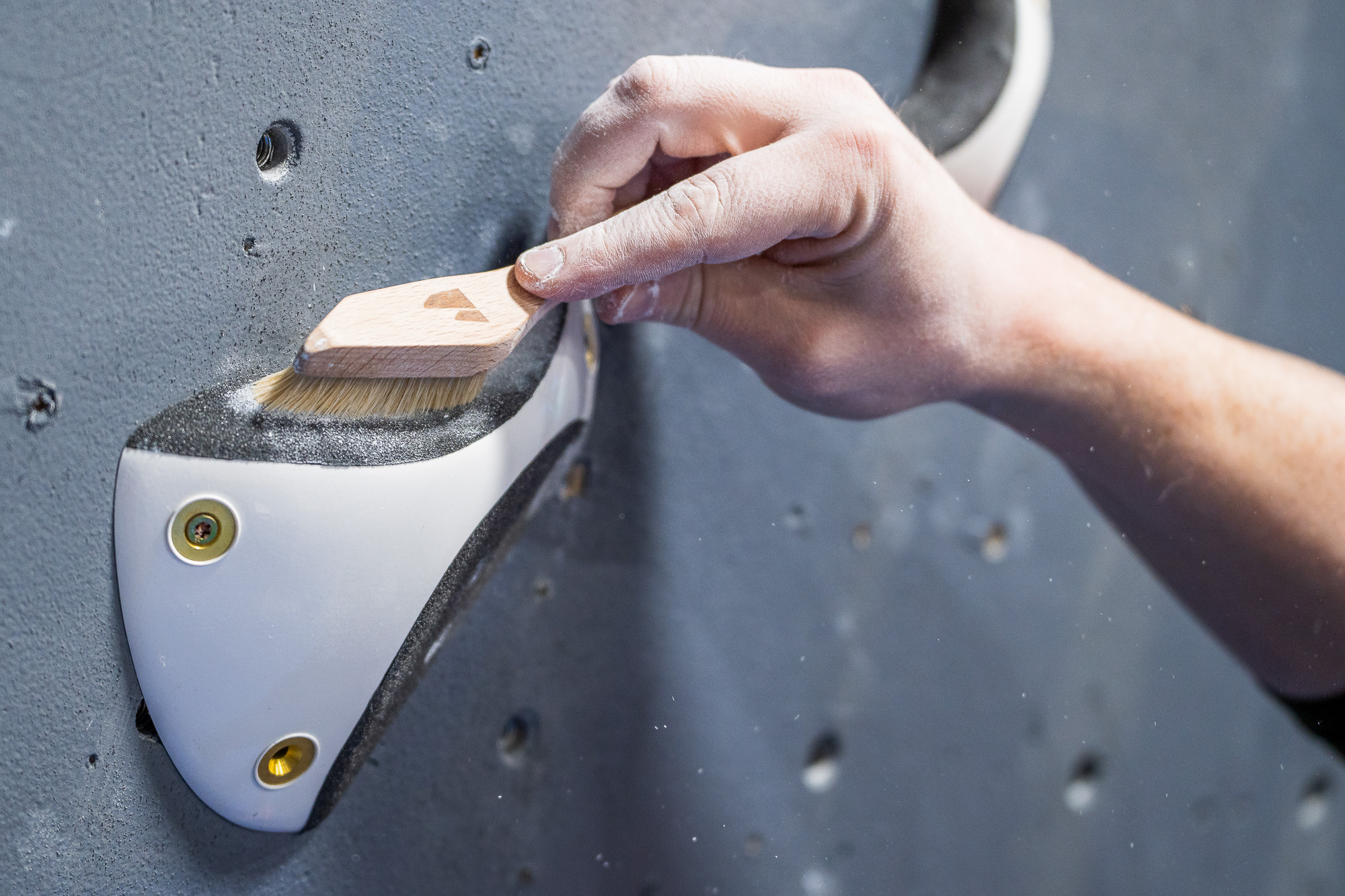Climbers tend to be an ecologically sensitive group. But they clamber on constantly changing routes in climbing gyms, potentially unconcerned about the sustainability of the thousands of polyurethane or polyester holds. Sadly, especially in North America, most of these holds end up in the dumpster after the texture wears off.
Although climbing hold recycling programs at rock gyms in the United States are nonexistent, the French are well on their way to creating a circular life cycle for climbing holds in large gym chains. Laws mandating the reduction or elimination of plastics apply to these gyms, and climbing hold manufacturers provide financial incentives and infrastructure to make recyclable climbing holds a reality.
According to the Climbing Business Journal, France threw out 7 million climbing holds in 2022. (The United States has over 600 indoor climbing gyms compared to France’s estimated 193.) That same year, the country enacted a law that mandates reducing and eliminating plastics.
The “anti-waste law for a circular economy” addresses everything from single-use plastics and packaging to requiring a plastic microfiber filter on washing machines. Of course, this law includes artificial climbing holds.
Here in the U.S., the adoption of recyclable climbing grips has lagged behind Europe. Trango Holds and Kilter are among the few American brands offering more sustainable holds. Read on for a review of the past, present, and potential future of improving the sustainability of indoor gym climbing.
Standard Climbing Hold Manufacturing
Entre Prises produced the first artificial climbing hold in 1983. Holds were “shaped” out of clay, and then the hardened clay was painted with resin. Some holds were carved natural stones or fired clay. These holds were rather archaic and painful to the skin, but there were no other choices for artificial climbing holds.
The next step in the manufacturing evolution of climbing holds, which still dominates the industry, was “pouring” climbing holds. A shaper created the hold shape from foam and then made a silicone mold around it.
Polyester resin (PE) was poured into these molds and cured. The resin vapors were toxic, and the holds were heavy and chipped easily. However, these polyester resin holds had a desirable texture, were easy to work with, and the material cost was relatively inexpensive. Again, Europe led the way.
In 1985, Metolius Climbing poured the first PE artificial “holds” in the United States. There were no climbing gyms in the U.S., so the market for holds didn’t exist yet. However, the demand for hangboards to train at home was just beginning, so the brand offered its “Simulator” hangboard before making holds a year later.
Polyurethane (PU) burst onto the climbing hold scene in 1991, and hold companies improved the mixtures to create an extremely durable and much lighter hold. PU holds also have some flexibility, unlike their PE counterparts, which allows them to be used on curved or featured walls. They are also much more resistant to chipping.
PU’s higher strength-to-weight ratio allows manufacturers to produce hollow holds, drastically reducing the amount of plastic used. These “hollow-back” holds also reduce shipping costs. These holds still dominate the walls of most climbing gyms.
The foam used to shape the mold contributes to the specific texture of the holds. Hold shapers used styrofoam and surfboard foam but eventually settled on high-density carving foam. Carving foam comes in various densities, allowing shapers to mimic natural textures or create their own.
The Next Step: Recyclable Climbing Holds
According to Climbing Business Journal, the first recyclable climbing hold was produced by Finland’s Greengrip Oy, which started making 100% recyclable climbing holds in 2006.
More recently, at least two other European brands have harnessed injection molding (instead of pouring) to create recyclable holds.
France’s Ghold produced its first recyclable climbing hold in late 2021 out of recyclable injection-molded thermoplastic for other brands like France’s Artline. Ghold can recycle its holds up to 10 times. The brand claims this reduces the carbon footprint by half, starting with the first recycling process.
The recyclable holds in Artline’s offerings have a QR code on the back, generating a free shipping label to return it to Ghold. Ghold guarantees free return shipping regardless of the climbing hold brand.
Greenholds of the Netherlands released recyclable injection-molded nylon holds in 2022. Greenhold uses 100% waste material, so this brand jumps into a recycling loop from the onset of each hold.
Once the hold ends its usable life, the owner returns it to the brand. A 20% material deposit goes toward replacement holds. Users who don’t want new holds will still receive a 5% return. Both brands mechanically break the holds down, melt them, and form new holds from the recycled material.
The Final Step: French Circular Climbing Hold Life Cycle


It’s one thing to offer recyclable artificial climbing holds but quite another to collect worn holds for recycling. Commercial climbing gyms must enter into a circular climbing hold economy and system to make a significant impact. Someone like me purchasing a handful of recyclable climbing holds will not put a significant dent into the millions upon millions of PE and PU holds heading to landfills.
France requires large French climbing gym networks, individually or as a group, to finance an ecological organization to manage the collection, sorting, and treatment of the products they bring to the market and the associated waste. This demand was challenging when the climbing gyms were recovering from the COVID-19 shutdowns — and the hold manufacturers were wrestling with the associated supply chain shortages.
But remarkably and rather quickly, the French gym climbing industry became one of the first to execute used climbing hold collection programs. And European hold companies started producing recyclable climbing holds, completing the circular life cycle of artificial holds.
Back in the States: Trango Holds ABS Line


Unfortunately, in the U.S., “recycling” climbing holds means the gyms sell or give away the worn-out holds. However, Trango Holds is one of the stateside brands making an attempt with its new six-set ABS collection.
ABS stands for Acrylonitrile Butadiene Styrene, and Trango Holds uses a partially recycled version to manufacture the holds. The proportion of recycled material depends on the color and shape of the hold and the availability of recyclable scraps. ABS itself is 100% recyclable.
ABS requires a new method of hold manufacturing called vacuum thermoforming (VTF). A sheet of oven-heated ABS is set onto a mold, and the air is vacuumed out of the mold to suck the sheet against it. ABS has a very high strength-to-weight ratio, allowing hollow-back holds that are only 6mm thick.
These holds are much lighter than PE or PU holds, sometimes weighing half as much. Trango Holds uses Candian manufacturer Binary Holds to produce its ABS collection.
As of the time of writing, Trango Holds cannot recycle the entire hold, nor does it offer a deposit or free return shipping. The customer contacts Trango Holds for shipping information to the nearest recycling partner. This partner cuts off the textured surface and recycles the rest.
Admittedly, this isn’t as circular or sustainable as the French system. However, what is possible today will hopefully improve when the first sets of Trango ABS holds are ready for retirement.
According to Ty Foose, longtime climbing hold shaper and Trango’s head of product, “Our ABS holds are not yet 100% recycled or 100% recyclable, although they have a high percentage of each and represent a vast improvement over traditional climbing hold materials. Trango is committed to working closely with our manufacturers to continually increase the sustainability of these processes.”
The Future Sustainability of Indoor Climbing


Surely, countries with strong sustainability standards and laws, like France, will continue to lead the way in sustainability efforts within the climbing gym industry. And, American brands like Trango Holds will continue to progress their own ways of reducing the amount of worn holds filling dumpsters and landfills. Time will tell if the government steps in or if climbing gym chains create hold collection programs and coordinate with manufacturers like Trango Holds.
Resurfacing Climbing Holds
One method of improving our current situation in the United States could revolve around resurfacing worn holds. Gyms retire holds when the surface texture is too worn for use by most climbers. Instead of attempting to recycle the material the hold is made from, removing the old texture and applying new textures could extend usable life by many factors.
Indeed, a few companies exist to improve the sustainability of commercial indoor climbing through refurbishing routes. Canada’s DÉLIRE Climbing Walls offers hold refurbishing, as does the U.K.’s Contact Refurbished. French brand NRHolds also provides refurbishing and retexturing services.
German hold brand Blocz goes one step further with its macro (large) line of holds. The brand starts with using 100% recycled industrial waste to form its macros, and then offers a DIY upcycling kit that allows the owner to retexture the holds.
Similarly, I’ve seen creative at-home methods for climbers with home gyms that involve coating a worn hold with polyester resin and pouring salt on it before it cures. After curing, the salt is washed off, leaving a new textured surface. The texture depends on the size of the salt granules (table salt, Epsom salt, kosher salt, etc.). Wetting the salt granules and letting them dry also alters the texture. The downside is that polyester resin itself isn’t recyclable.
Other Strategies to Improve Sustainability of Gym Climbing
Some hold brands use wood to make climbing holds. Although a worn wood hold can’t be directly reworked into a new hold, it can be sanded down to reveal its original minimal texture. A wood hold could also undergo subtractive manufacturing to create a new, smaller hold. Overall, using wood to make holds is less impactful, and the holds are renewable in other ways.
A few brands use different mixtures of materials to use less of the nonrenewable components. Some use bio-based materials, further reducing the negative impacts of poly-based holds.
In a similar move, Metolius Climbing offers small “foot chips” made of aluminum. Although the texture is unfriendly to hands and fingers, these “Mini Tech Footholds” would take so much longer to wear out.
More resurfacing methods may evolve, and manufacturers could engineer original textures to last much longer. Longer-lasting textures would reduce environmental impacts from a more effective point.
As the number of climbing gyms continues to grow, the problem of waste holds concurrently expands with it. Rock climbers tend to be a frugal and inventive bunch, and ultimately, recycling or refurbishing holds saves money. There is nothing like having an empty wallet and overflowing stoke to drive sustainable innovation!
